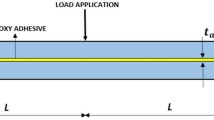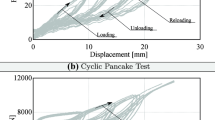Abstract
In this study, a Cohesive Zone Model (CZM) was used to predict the progressive failure behavior of adhesive joining of a domeseparated composite pressure vessel according to variation in the temperatures. A set of cohesive zone parameters for the adhesive material were obtained through Mode I, Mode II, and Mixed Mode I/II interfacial fracture toughness tests. In order to evaluate the effect of temperature on the interfacial fracture toughness, in situ temperature environments were simulated in the range -30 to 60oC, using an environmental chamber and furnace. The double-lap joint test was suggested as a way to verify the proposed CZM and simulation procedure. It was found that good accuracy in the prediction of debonding loads, and the damage onset and growth of adhesive joining, was obtained between the numerical predictions and the experimental results. The results of progressive failure analysis of the adhesive joining of the dome-separated composite pressure vessel showed that the maximum debonded length was predicted to be about 6.0% of the total adhesive length and that the damage onset and propagation behavior of the adhesive joining showed a similar tendency under room and low-temperature environments. However, in the high-temperature environment (60oC), the debonding of the adhesive joining tended to propagate early and quickly compared to the same action under room and low-temperature conditions.
Similar content being viewed by others
Abbreviations
- a:
-
crack length
- b:
-
width of the specimen
- c:
-
lever length
- E1f :
-
modulus of elasticity in the fiber direction measured in flexure
- GI :
-
mode I energy release rate
- GII :
-
mode II energy release rate
- GIC :
-
critical energy release rate for mode I
- GIIC :
-
critical energy release rate for mode II
- GC :
-
sum of GIC and GIIC
- GT :
-
total energy release rate
- GII/GT :
-
mixed mode ratio
- h:
-
half-thickness of specimen
- K:
-
cohesive stiffness
- L:
-
half-span of specimen
- N:
-
interfacial normal tensile strength
- P:
-
load
- ri :
-
radius of random place on the dome
- ro :
-
opening radius
- rc :
-
radius of cylinder
- S:
-
interfacial sliding shear strength
- T:
-
interfacial scissoring shear strength
- ti :
-
thickness of random place on the dome
- tc :
-
thickness of cylinder of composite pressures vessel
- ai :
-
winding angle of random place on the dome
- ac :
-
winding angle of cylinder of composite pressures vessel
- δ:
-
displacement
- δf :
-
cohesive ductility
- ti(i=1,2,3):
-
interfacial normal or shear tractions for pure mode i
- tult :
-
ultimate stress
- χ:
-
crack length correction parameter
References
Kim, J., Shin, K., and Hwang, T., “Progressive Failure Analysis of Adhesive Joints of Filament-Wound Composite Pressure Vessel,” Transactions of the Korean Society of Mechanical Engineers A, Vol. 38, No. 11, pp. 1265–1272, 2014.
Zemcik, R. and Las, V., “Numerical and Experimental Analyses of the Delamination of Cross-Ply Laminates,” Materiali in Tehnologije, Vol. 42, No. 4, pp. 171–174, 2008.
Blanco, N., Turon, A., and Costa, J., “An Exact Solution for the Determination of the Mode Mixture in the Mixed-Mode Bending Delamination Test,” Composites Science and Technology, Vol. 66, No. 10, pp. 1256–1258, 2006.
Ozdil, F., Carlsson, L., and Li, X., “Characterization of Mode II Delamination Growth in Glass/Epoxy Composite Cylinders,” Journal of Composite Materials, Vol. 34, No. 4, pp. 274–298, 2000.
Sarrado, C., Turon, A., Costa, J., and Renart, J., “On the Validity of Linear Elastic Fracture Mechanics Methods to Measure the Fracture Toughness of Adhesive Joints,” International Journal of Solids and Structures, Vol. 81, No. pp. 110–116, 2016.
Burlayenko, V., Altenbach, H., Sadowski, T., and Dimitrova, S., “Computational Simulations of Thermal Shock Cracking by the Virtual Crack Closure Technique in a Functionally Graded Plate,” Computational Materials Science, Vol. 116, pp. 11–21, 2016.
Yang, Z. J., Chen, J. F., and Holt, G. D., “Efficient Evaluation of Stress Intensity Factors Using Virtual Crack Extension Technique,” Computers & Structures, Vol. 79, No. 31, pp. 2705–2715, 2001.
Pirondi, A. and Nicoletto, G., “Simulation of Fracture in Bonded Joints with a Cohesive Zone Model,” Proc. of the 15th European Conference on Fracture, ECF15, 2004.
Camanho, P. P., Davila, C. G., and De Moura, M. F., “Numerical Simulation of Mixed-Mode Progressive Delamination in Composite Materials,” Journal of Composite Materials, Vol. 37, No. 16, pp. 1415–1438, 2003.
Alfano, G., “On the Influence of the Shape of the Interface Law on the Application of Cohesive-Zone Models,” Composites Science and Technology, Vol. 66, No. 6, pp. 723–730, 2006.
De Moura, M., Gonçalves, J., Chousal, J., and Campilho, R., “Cohesive and Continuum Mixed-Mode Damage Models Applied to the Simulation of the Mechanical Behaviour of Bonded Joints,” International Journal of Adhesion and Adhesives, Vol. 28, No. 8, pp. 419–426, 2008.
Cytec Engineered Materials, “FM®73 Epoxy Film Adhesive Technical Data Sheet,” http://www.argosyinternational.com/sites/ default/files/datasheet/FM_73_081111.pdf (Accessed 25 OCT 2017)
ASTM D5528-01, “Standard Test Method for Mode I Interlaminar Fracture Toughness of Unidirectional Fiber-Reinforced Polymer Matrix Composites,” 2001.
ASTM D6671, “Standard Test Method for Mixed Mode I-Mode II Interlaminar Fracture Toughness of Unidirectional Fiber Reinforced Polymer Matrix Composites” 2006.
Pereira, A., De Morais, A., Marques, A., and De Castro, P., “Mode II Interlaminar Fracture of Carbon/Epoxy Multidirectional Laminates,” Composites Science and Technology, Vol. 64, No. 10, pp. 1653–1659, 2004.
Hodgkinson, J. M., “Mechanical Testing of Advanced Fibre Composites,” Elsevier, 2000.
Borg, R., Nilsson, L., and Simonsson, K., “Simulating DCB, ENF and MMB Experiments Using Shell Elements and a Cohesive Zone Model,” Composites Science and Technology, Vol. 64, No. 2, pp. 269–278, 2004.
JIS K 7068, “Testing Methods for Interlaminar Fracture Toughness of Carbon Fibre Reinforced Plastics,” 1993.
Hodgkinson, J. M., “Mechanical Testing of Advanced Fibre Composites,” Elsevier, 2000.
ASTM D3528-96, “Standard Test Method for Strength Properties of Double Lap Shear Adhesive Joints by Tension Loading,” 2002.
Camanho, P. P., Davila, C. G., and Ambur, D. R., “Numerical Simulation of Delamination Growth in Composite Materials,” NASA, 2001.
Cui, W., Wisnom, M., and Jones, M., “A Comparison of Failure Criteria to Predict Delamination of Unidirectional Glass/Epoxy Specimens Waisted through the Thickness,” Composites, Vol. 23, No. 3, pp. 158–166, 1992.
Perillo, G., Vedvik, N. P., and Echtermeyer, A. T., “Numerical Analyses of Low Velocity Impacts on Composite. Advanced Modelling Techniques,” Proc. of the Simulia Customer Conference, 2012.
Kenane, M. and Benzeggagh, M. L., “Mixed-Mode Delamination Fracture Toughness of Unidirectional Glass/Epoxy Composites under Fatigue Loading,” Composites Science and Technology, Vol. 57, No. 5, pp. 597–605, 1997.
Diehl, T., “On Using A Penalty-Based Cohesive-Zone Finite Element Approach, Part I: Elastic Solution Benchmarks,” International Journal of Adhesion and Adhesives, Vol. 28, No. 4, pp. 237–255, 2008.
Im, J., Shin, K., and Hwang, T., “Evaluation of Mechanical Properties of Carbon/Epoxy Composites under in Situ Low- and High-Temperature Environments,” Transactions of the Korean Society of Mechanical Engineers A, Vol. 39, No. 6, pp. 567–573, 2015.
Jeon, K.-W., Shin, K.-B., and Hwang, T.-K., “A Study on the Structural Analysis of Joint Part in Accordance with Adhesive Length of a Composite Rocket Motor Case,” Journal of the Korean Society of Propulsion Engineers, Vol. 16, No. 3, pp. 90–96, 2012.
Acknowledgements
This work supported by the Agency for Defense Development (ADD) and the National Research Foundation of Korea (NRF) grant funded by the Korea government (MOE) (No. 2015R1D1A1A01060 750).
Author information
Authors and Affiliations
Corresponding author
Rights and permissions
About this article
Cite this article
Im, JM., Kang, SG., Shin, KB. et al. Prediction of onset and propagation of damage in the adhesive joining of a dome-separated composite pressure vessel including temperature effects. Int. J. Precis. Eng. Manuf. 18, 1795–1804 (2017). https://doi.org/10.1007/s12541-017-0208-z
Received:
Revised:
Accepted:
Published:
Issue Date:
DOI: https://doi.org/10.1007/s12541-017-0208-z




